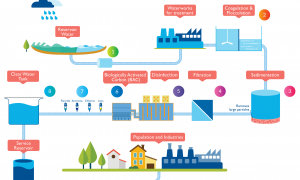🕑 Reading time: 1 minute
Contents:
- What is cross drainage works?
- Types of Cross Drainage works:
- Type – 1: Cross drainage work carrying canal over the drain
- Type – 2: Cross Drainage work carrying Drainage over the canal
- Type –3: Cross drainage works admitting canal water into the canal
- Type – 1: Canal over drainage [HFL < FSL]
- Aqueduct:
- Syphon Aqueduct:
- Type – 2: Drainage over canal (HFL > FSL)
- Super Passage:
- Canal Syphon:
- Type –3: Drainage admitted into canal (HFL = FSL)
- Level Crossing:
- Canal inlets:
What is cross drainage works?
Cross drainage works is a structure constructed when there is a crossing of canal and natural drain, to prevent the drain water from mixing into canal water. This type of structure is costlier one and needs to be avoided as much as possible. Cross drainage works can be avoided in two ways:- By changing the alignment of canal water way
- By mixing two or three streams into one and only one cross drainage work to be constructed, making the structure economical.
Types of Cross Drainage works:
There are three types of cross drainage works structures:Type – 1: Cross drainage work carrying canal over the drain
The structures falling under this type are- Aqueduct
- Syphon Aqueduct
Type – 2: Cross Drainage work carrying Drainage over the canal
The structures falling under this type are- Super passage
- Canal Syphon
Type –3: Cross drainage works admitting canal water into the canal
The structures falling under this type are- Level Crossing
- Canal inlets
Type – 1: Canal over drainage [HFL < FSL]
Aqueduct:
In an aqueduct, the canal bed level is above the drainage bed level so canal is to be constructed above drainage. A canal trough is to be constructed in which canal water flows from upstream to downstream. This canal trough is to be rested on number of piers. The drained water flows through these piers upstream to downstream. The canal water level is referred as full supply level (FSL) and drainage water level is referred as high flood level (HFL). The HFL is below the canal bed level. Aqueduct is similar to a bridge, instead of roadway or railway, canal water are carried in the trough and below that the drainage water flows under gravity and possessing atmospheric pressure.
Fig (a) Aqueduct
Syphon Aqueduct:
In a syphon aqueduct, canal water is carrier above the drainage but the high flood level (HFL) of drainage is above the canal trough. The drainage water flows under syphonic action and there is no presence of atmospheric pressure in the natural drain. The construction of the syphon aqueduct structure is such that, the flooring of drain is depressed downwards by constructing a vertical drop weir to discharge high flow drain water through the depressed concrete floor. Syphonic aqueducts are more often constructed and better preferred than simple Aqueduct, though costlier.
Fig (b) Syphon Aqueduct
Type – 2: Drainage over canal (HFL > FSL)
Super Passage:
Super passage structure carries drainage above canal as the canal bed level is below drainage bed level. The drainage trough is to be constructed at road level and drainage water flows through this from upstream to downstream and the canal water flows through the piers which are constructed below this drainage trough as supports. The full supply level of canal is below the drainage trough in this structure. The water in canal flows under gravity and possess the atmospheric pressure. This is simply a reverse of Aqueduct structure.
Fig (c) Super passage
Canal Syphon:
In a canal syphon, drainage is carried over canal similar to a super passage but the full supply level of canal is above than the drainage trough.so the canal water flows under syphonic action and there is no presence of atmospheric pressure in canal. When compared, super passage is more often preferred than canal Syphon because in a canal Syphon, big disadvantage is that the canal water is under drainage trough so any defective minerals or sediment deposited cannot be removed with ease like in the case of a Syphon Aqueduct. Flooring of canal is depressed and ramp like structure is provided at upstream and downstream to form syphonic action. This structure is a reverse of Syphon aqueduct.
Fig (d) Canal Syphon
Type –3: Drainage admitted into canal (HFL = FSL)
In this case, the drainage water is to be mixed up with canal water, here the cost of construction is less but silt clearance and maintenance of canal water becomes really difficult. So the structures falling under this category are constructed with utmost care.Level Crossing:
When the bed level of canal is equal to the drainage bed level, then level crossing is to be constructed. This consists of following steps:- Construction of weir to stop drainage water behind it
- Construction of canal regulator across a canal
- Construction of head regulator across a Drainage

Figure (e) Level crossing
Canal inlets:
In a canal inlet structure, the drainage water to be admitted into canal is very less. The drainage is taken through the banks of a canal at inlet. And then this drainage mixed with canal travels certain length of the canal, after which an outlet is provided to create suction pressure and suck all the drainage solids, disposing it to the watershed area nearby. There are many disadvantages in use of canal inlet structure, because the drainage may pollute canal water and also the bank erosion may take place causing the canal structure deteriorate so that maintenance costs are high. Hence this type of structure is rarely constructed.
Figure (f) Canal inlet plan and cross sectional views (a) pipe type (b) open cut type


